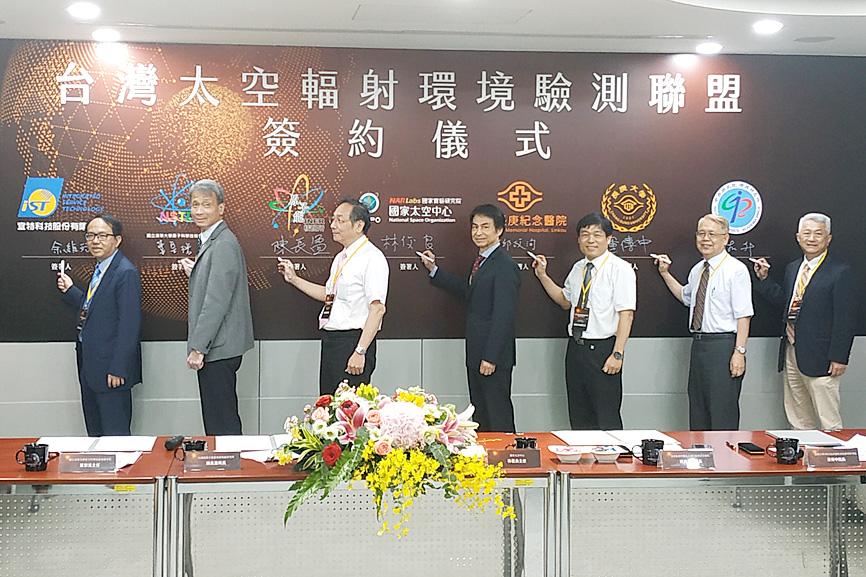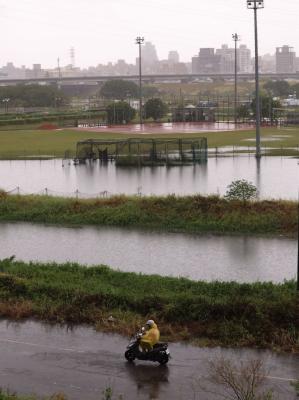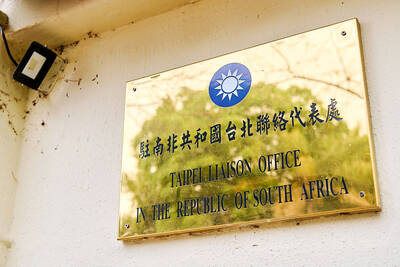An alliance to promote space-level radioactivity resistance testing has been established to help local firms connect with the global space industry, the National Applied Research Laboratories (NARL) said yesterday.
After Taiwan’s first domestically produced satellite Formosat-5 was launched in 2017 to supply remote-sensing images, the nation has worked harder to foster a space industry and last year established the Taiwan Space Industry Development Association.
The alliance aims to help Taiwan evolve from a nation with a booming semiconductor industry to one supplying electronic components that can withstand space-level radioactivity, it said.

Photo courtesy of the National Space Organization
The NARL-affiliated National Space Organization, which leads the association, would be tasked with establishing a platform and standards for verifying components’ resistance to space-level radioactivity, it added.
The organization on Tuesday signed memorandums of understanding to cooperate with Chang Gung Memorial Hospital in Linkou, Chang Gung University’s Institute for Radiological Research, the Atomic Energy Council’s Institute of Nuclear Energy Research, Academia Sinica’s Institute of Physics, National Tsing Hua University’s Nuclear Science and Technology Development Center, as well as Integrated Service Technology Inc, it said.
As protons are found in nearly 95 percent of the environment in low-Earth orbit, or 106km to 1,000km above the Earth, the alliance’s service would encompass the impact of protons on electronic components, it added.
The company would be in charge of testing commercial components, while the hospital would utilize its proton radiation instruments, originally used for treatment, to test the effects of radiation, the NARL said.
The Nuclear Science and Technology Development Center would employ its instruments to produce high-energy gamma rays to simulate space radiation, while the Institute of Physics and Chang Gung University would help with data analysis, it said.
In addition to providing a one-stop service, the alliance would produce analysis reports for suppliers to improve their product designs and manufacturing processes, the NARL said.

Taipei, New Taipei City, Keelung and Taoyuan would issue a decision at 8pm on whether to cancel work and school tomorrow due to forecasted heavy rain, Keelung Mayor Hsieh Kuo-liang (謝國樑) said today. Hsieh told reporters that absent some pressing reason, the four northern cities would announce the decision jointly at 8pm. Keelung is expected to receive between 300mm and 490mm of rain in the period from 2pm today through 2pm tomorrow, Central Weather Administration data showed. Keelung City Government regulations stipulate that school and work can be canceled if rain totals in mountainous or low-elevation areas are forecast to exceed 350mm in

EVA Airways president Sun Chia-ming (孫嘉明) and other senior executives yesterday bowed in apology over the death of a flight attendant, saying the company has begun improving its health-reporting, review and work coordination mechanisms. “We promise to handle this matter with the utmost responsibility to ensure safer and healthier working conditions for all EVA Air employees,” Sun said. The flight attendant, a woman surnamed Sun (孫), died on Friday last week of undisclosed causes shortly after returning from a work assignment in Milan, Italy, the airline said. Chinese-language media reported that the woman fell ill working on a Taipei-to-Milan flight on Sept. 22

COUNTERMEASURE: Taiwan was to implement controls for 47 tech products bound for South Africa after the latter downgraded and renamed Taipei’s ‘de facto’ offices The Ministry of Foreign Affairs is still reviewing a new agreement proposed by the South African government last month to regulate the status of reciprocal representative offices, Minister of Foreign Affairs Lin Chia-lung (林佳龍) said yesterday. Asked about the latest developments in a year-long controversy over Taiwan’s de facto representative office in South Africa, Lin during a legislative session said that the ministry was consulting with legal experts on the proposed new agreement. While the new proposal offers Taiwan greater flexibility, the ministry does not find it acceptable, Lin said without elaborating. The ministry is still open to resuming retaliatory measures against South

1.4nm WAFERS: While TSMC is gearing up to expand its overseas production, it would also continue to invest in Taiwan, company chairman and CEO C.C. Wei said Taiwan Semiconductor Manufacturing Co (TSMC) has applied for permission to construct a new plant in the Central Taiwan Science Park (中部科學園區), which it would use for the production of new high-speed wafers, the National Science and Technology Council said yesterday. The council, which supervises three major science parks in Taiwan, confirmed that the Central Taiwan Science Park Bureau had received an application on Friday from TSMC, the world’s largest contract chipmaker, to commence work on the new A14 fab. A14 technology, a 1.4 nanometer (nm) process, is designed to drive artificial intelligence transformation by enabling faster computing and greater power